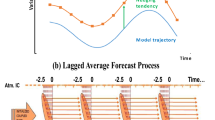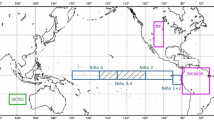Abstract
The seasonal forecast skill of the NASA Global Modeling and Assimilation Office atmosphere–ocean coupled global climate model (AOGCM) is evaluated based on an ensemble of 9-month lead forecasts for the period 1993 to 2010. The results from the current version (V2) of the AOGCM consisting of the GEOS-5 AGCM coupled to the MOM4 ocean model are compared with those from an earlier version (V1) in which the AGCM (the NSIPP model) was coupled to the Poseidon Ocean Model. It was found that the correlation skill of the Sea Surface Temperature (SST) forecasts is generally better in V2, especially over the sub-tropical and tropical central and eastern Pacific, Atlantic, and Indian Ocean. Furthermore, the improvement in skill in V2 mainly comes from better forecasts of the developing phase of ENSO from boreal spring to summer. The skill of ENSO forecasts initiated during the boreal winter season, however, shows no improvement in terms of correlation skill, and is in fact slightly worse in terms of root mean square error (RMSE). The degradation of skill is found to be due to an excessive ENSO amplitude. For V1, the ENSO amplitude is too strong in forecasts starting in boreal spring and summer, which causes large RMSE in the forecast. For V2, the ENSO amplitude is slightly stronger than that in observations and V1 for forecasts starting in boreal winter season. An analysis of the terms in the SST tendency equation, shows that this is mainly due to an excessive zonal advective feedback. In addition, V2 forecasts that are initiated during boreal winter season, exhibit a slower phase transition of El Nino, which is consistent with larger amplitude of ENSO after the ENSO peak season. It is found that this is due to weak discharge of equatorial Warm Water Volume (WWV). In both observations and V1, the discharge of equatorial WWV leads the equatorial geostrophic easterly current so as to damp the El Nino starting in January. This process is delayed by about 2 months in V2 due to the slower phase transition of the equatorial zonal current from westerly to easterly.














Similar content being viewed by others
Notes
The US National Multi-Model Ensemble (NMME) is an experimental multi-model seasonal forecasting system consisting of coupled models from NOAA/NCEP, NOAA/GFDL, IRI, NCAR, NASA, and Canada's CMC.
References
Adler RF et al (2003) The version 2 global precipitation climatology project (GPCP) monthly precipitation analysis (1979-present). J Hydrometeorol 4:1147–1167
McPhaden M et al (2010) The global tropical moored buoy array. In Hall J, Harrison DE, Stammer D (eds) Proceedings of OceanObs’09: sustained ocean observations and information for society (Vol. 2), Venice, Italy, 21–25 September 2009. ESA Publication WPP-306, doi:10.5270/OceanObs09.cwp.61
Bacmeister J, Pegion PJ, Schubert SD, Suarez MJ (2000) Atlas of seasonal means simulated by the NSIPP 1 atmospheric GCM. NASA Tech. Memo. 2000–104606, Vol. 17, 194 pp
Balmaseda MA, Anderson D (2009) Impact of initialization strategies and observations on seasonal forecast skill. Geophys Res Lett 36:L01701. doi:10.1029/2008GL035561
Barnston AG (1992) Correspondence among the correlation, RMSE, and Heidke forecast verification measures; refinement of the Heidke score. Wea Forecast 7:699–709
Barthelet P, Terray L, Valcke S (1998) Transient CO2 experiment using the ARPEGE/OPAICE non flux corrected coupled model. Geophys Res Lett 25:2277–2280
Behringer DW, Xue Y (2004) Evaluation of the global ocean data assimilation system at NCEP: the Pacific Ocean. Preprints, eighth symposium on integrated observing and assimilation systems for atmosphere, ocean and land surface, Seattle, WA, Amer Meteor Soc, pp 11–15. [Available online at http://ams.confex.com/ams/84Annual/webprogram/Paper70720.html.]
Behringer DW, Ming J, Ants L (1998) An improved coupled model for ENSO prediction and implications for ocean initialization. Part I: the ocean data assimilation system. Mon Wea Rev 126:1013–1021
Chen D, Cane MA, Kaplan A, Zebiak SE, Huang DJ (2004) Predictability of El Nino over the past 148 years. Nature 428:733–736
Danabasoglu G et al (2006) Diurnal coupling in the tropical oceans of CCSM3. J Clim 19(11):2347–2365
Dee D et al (2011) The ERA-interim reanalysis: configuration and performance of the data assimilation system. Quart J Roy Meteor Soc 137:553–597
Gordon C, Cooper C, Senior CA, Banks H, Gregory JM, Johns TC, Mitchell JFB, Wood RA (2000) The simulation of SST, sea ice extents and ocean heat transports in a version of the Hadley Centre coupled model without flux adjustment. Clim Dyn 16:147–168
Griffies SM et al (2005) Formulation of an ocean model for global climate simulations. Ocean Sci 1:45–79
Ham Y-G, Kug J-S (2012) How well do current climate models simulate two-types of El Nino? Clim Dyn 39:383–398. doi:10.1007/s00382-011-1157-3
Ham Y-G, Kug J-S, Kang I-S, Jin F-F, Timmermann A (2010) Impact of diurnal atmosphere–ocean coupling on tropical climate simulations using a coupled GCM. Clim Dyn 34(6):905–917
Ham Y-G, Kang I-S, Kim D, Kug J-S (2012a) El-Nino southern oscillation simulated and predicted in SNU coupled GCMs. Clim Dyn 38:2227–2242. doi:10.1007/s00382-011-1171-5
Ham Y-G, Kang I-S, Kug J-S (2012b) Coupled bred vectors in the tropical pacific and their application to ENSO prediction. Prog Oceanogr 105:90–101. doi:10.1016/j.pocean.2012.04.005
Ham Y-G, Schubert S, Chang Y (2012c) Optimal initial perturbations for ensemble prediction of the madden-julian oscillation during boreal winter. J Clim 25:4932–4945. doi:10.1175/JCLI-D-11-00344.1
Ham Y-G, Rienecker MM, Schubert S, Marshak J, Yeh S-W, Yang S-C (2012d) The decadal modulation of coupled bred vectors. Geophy Res Lett 37:L20712. doi:10.1029/2012GL053719
Harrison DE, Vecchi GA (1999) On the termination of El Niño. Geophys Res Lett 26(11):1593–1596
Jin F-F (1997) An equatorial recharge paradigm for ENSO. Part I: conceptual model. J Atmos Sci 54:811–829
Jin F-F, Kim ST, Bejarano L (2006) A coupled-stability index for ENSO. Geophys Res Lett 33:L23708. doi:10.1029/2006GL027221
Kang I-S, An S-I, Jin F-F (2001) A systematic approximation of the SST anomaly equation for ENSO. J Meteor Soc Jpn 79:1–10
Keppenne CL, Rienecker MM, Jacob JP, Kovach R (2008) Error covariance modeling in the GMAO ocean ensemble Kalman filter. Mon Weather Rev 136:2964–2982
Kim S, Jin FF (2011) An enso stability analysis. Part II: results from the twentieth and twenty-first century simulations of the CMIP3 models. Clim Dyn 36:1609–1627
Kim D, Jang Y-S, Kim D-H, Kim Y-H, Watanabe M, Jin F-F, Kug J-S (2011) El Niño-Southern Oscillation sensitivity to cumulus entrainment in a coupled general circulation model. J Geophys Res 116:D22112. doi:10.1029/2011JD016526
Koster R, Suarez M (1992) Modeling the land surface boundary in climate models as a composite of independent vegetation stands. J Geophys Res 97:2697–2715
Kug J-S, Kang I-S, An S-I (2003) Symmetric and anti-symmetric mass exchanges between the equatorial and off-equatorial Pacific associated with ENSO. J Geophy Res Oceans 108(C8):3284
Large WG, McWilliams JC, Doney SC (1994) Oceanic vertical mixing: a review and a model with a nonlocal boundary layer parameterization. Rev Geophys 32(4):363–403. doi:10.1029/94RG01872
Lin S-J (2004) A vertically Lagrangian finite-volume dynamical core for global models. Mon Wea Rev 132:2293–2307
Luo J-J, Masson S, Roeckner E, Madec G, Yamagata T (2005) Reducing climatology bias in an ocean–atmosphere CGCM with improved coupling physics. J Clim 18:2344–2360
Molod A, Takacs L, Suarez M, Bacmeister J, Song I-S, Eichmann A (2012) The GEOS-5 atmospheric general circulation model: mean climate and development from MERRA to fortuna. Technical report series on global modeling and data assimilation, 28
Molteni F, et al. (2011) The new ECMWF seasonal forecast system (System 4). ECMWF Technical Memorandum 656
Moorthi S, Suarez MJ (1992) Relaxed Arakawa–Schubert: a parameterization of moist convection for general circulation models. Mon Wea Rev 120:978–1002
Murphy JM (1988) The impact of ensemble forecasts on predictability. Q J R Meteorol Soc 114:463–493
Palmer TN et al (2004) Development of a European multimodal ensemble system for seasonal-to-interannual prediction (DEMETER). Bull Amer Meteor Soc 85:853–872
Rienecker MM, et al. (2007) The GEOS-5 data assimilation system—documentation of versions 5.0.1, 5.1.0, and 5.2.0. NASA/TM-2007-104606, Vol. 27
Rienecker MM et al (2011) MERRA: NASA’s modern-era retrospective analysis for research and applications. J Clim 24:3624–3648
Roberts MJ et al (2004) Impact of an eddy permitting ocean resolution on control and climate change simulations with a global coupled GCM. J Clim 17:3–20
Rogel P, Weaver AT, Daget N, Ricci S, Machu E (2005) Ensembles of global ocean analyses for seasonal climate prediction: impact of temperature assimilation. Tellus A 57:375–386
Rosati A, Miyakoda K, Gudgel R (1997) The impact of ocean initial conditions on ENSO forecasting with a coupled model. Mon Wea Rev 125:754–772
Saha S et al (2006) The NCEP climate forecast system. J Clim 19:3483–3517
Schopf P, Loughe A (1995) A reduced-gravity isopycnal ocean model: hindcasts of El Nino. Mon Wea Rev 123:2839–2863
Tang Y, Kleeman R (2002) A new strategy for assimilating SST data for ENSO predictions. Geophys Res Lett 29: 1841. doi:10.1029/2002GL014860
Vernieres G, et al (2013) The GEOS-ODAS, description and evaluation. NASA Technical Memorandum (in preparation)
Wang B, et al (2009) Advance and prospectus of seasonal prediction: assessment of the APCC/CliPAS 14-model ensemble retrospective seasonal prediction (1980–2004). Clim Dyn 33, doi:10.1007/s00382-008-0460-0
Wang G, Kleeman R, Smith N, Tseitkin F (2002) The BMRC coupled general circulation model ENSO forecast system. Mon Wea Rev 130:975–991
Washington WM et al (2000) Parallel climate model (PCM) control and transient simulations. Clim Dyn 16:755–774
Watanabe M, Chikira M, Imada Y, Kimoto M (2011) Convective control of ENSO simulated in MIROC. J Clim 24:543–562
Yin Y, Alves O, Oke PR (2011) An ensemble ocean data assimilation system for seasonal prediction. Mon Wea Rev 139:786–808
Yoo J-H, Kang I-S (2005) Theoretical examination of a multi-model composite for seasonal prediction. Geophys Res Lett 32:L15711. doi:10.1029/2005GL023513
Yuan X, Wood EF, Luo LF, Pan M (2011) A first look at climate forecast system version 2 (CFSv2) for hydrological seasonal prediction. Geophys Res Lett 38:L13402. doi:10.1029/2011GL047792
Zhang S, Harrison MJ, Rosati A, Wittenberg A (2007) System design and evaluation of coupled ensemble data assimilation for global oceanic climate studies. Mon Wea Rev 135:3541–3564
Acknowledgments
YGH was funded by the Korea Meteorological Administration Research and Development Program under grant CATER 2012-3041. And, we are grateful for the comments from Christian L. Keppenne to provide a detail information about the initialization systems.
Author information
Authors and Affiliations
Corresponding author
Rights and permissions
About this article
Cite this article
Ham, YG., Schubert, S., Vikhliaev, Y. et al. An assessment of the ENSO forecast skill of GEOS-5 system. Clim Dyn 43, 2415–2430 (2014). https://doi.org/10.1007/s00382-014-2063-2
Received:
Accepted:
Published:
Issue Date:
DOI: https://doi.org/10.1007/s00382-014-2063-2




